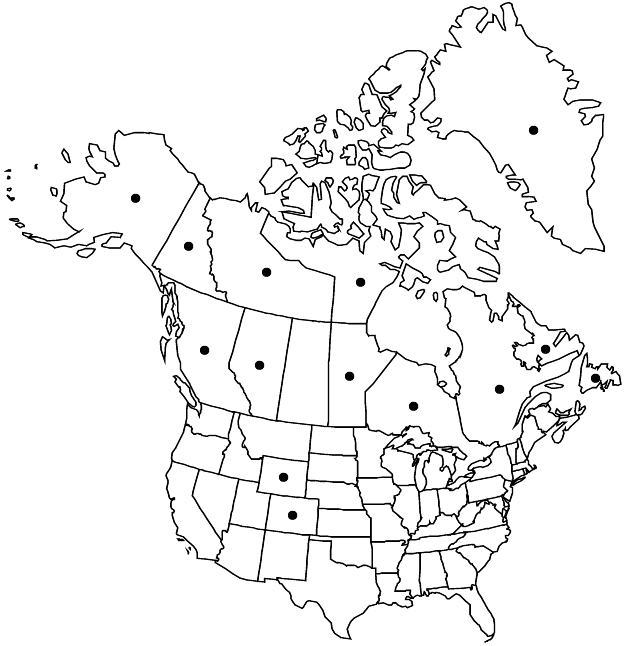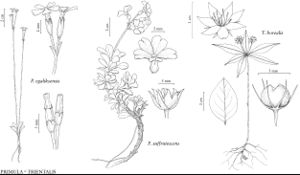Primula egaliksensis
in G. C. Oeder et al., Fl. Dan. 9(26): 2, plate 1511. 1816 ,.
Plants 4–12.5 cm, herbaceous; rhizomes thin, short; rosettes not clumped; vegetative parts efarinose. Leaves not aromatic, abruptly petiolate; petiole not winged; blade without deep reticulate veins abaxially, elliptic, 1.5–5.5 × 0.5–0.9 cm, thin, margins entire, undulate, or slightly denticulate, apex rounded, surfaces glabrous. Inflorescences 1–3 (–6) -flowered; involucral-bracts gibbous but not auriculate, ± equal. Pedicels nodding, thin, 2–9 mm, length 1–3 times bracts, flexuous. Flowers homostylous; calyx green or with purple stripes, cylindric, 4–6 mm; corolla white or lavender, tube 6–8 mm, length 1–1.2 times calyx, eglandular, limb 6–8 mm diam., lobes 3–4 mm, apex slightly emarginate. Capsules narrowly cylindric, length 1.5–2 times calyx. Seeds without flanged edges, reticulate. 2n = 36, ca. 40.
Phenology: Flowering summer.
Habitat: Stream banks, bogs
Elevation: 0-2400 m
Distribution

Greenland, Alta., B.C., Man., Nfld. and Labr., N.W.T., Nunavut, Ont., Que., Yukon, Alaska, Colo., Wyo., e Asia (Russian Far East)
Discussion
Primula egaliksensis is distinguished by its relatively few-flowered inflorescence of homostylous flowers; violet (forma violacea Fernald) and white corollas are equally common and sometimes occur together within populations. Early treatments of the arctic flora confused P. egaliksensis with other species, notably P. stricta. The names P. farinosa var. groenlandica Pax and P. sibirica in the sense of Hooker (not Jacquin) refer in part to P. egaliksensis.
Morphologic and genetic evidence (A. Guggisberg et al. 2006) indicates that Primula egaliksensis is a hybrid between sects. Aleuritia and Armerina, with probable parents being P. nutans and P. mistassinica or an ancestral form of that species. The rounded, petiolate leaves and narrow capsules ally it strongly to sect. Armerina, and it has traditionally been placed in that section. Primula egaliksensis has frequently been confused with P. nutans; it differs in its smaller, homostylous flowers and the absence of auriculate bracts.
Selected References
None.
Lower Taxa
No values specified."-2timescalyx" is not declared as a valid unit of measurement for this property."-3timesbracts" is not declared as a valid unit of measurement for this property."thin" is not a number."-1.2timescalyx" is not declared as a valid unit of measurement for this property.
